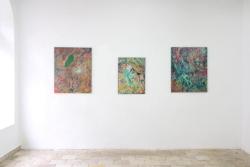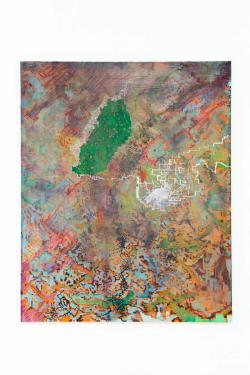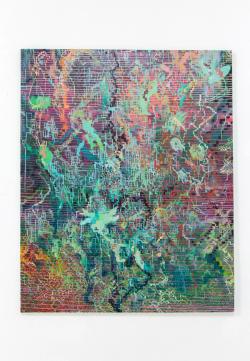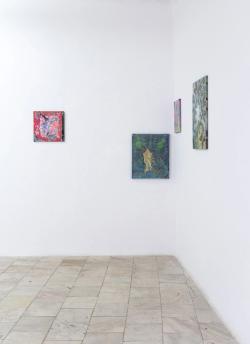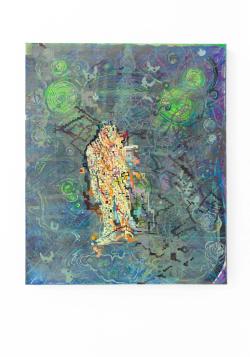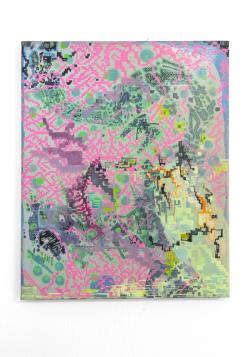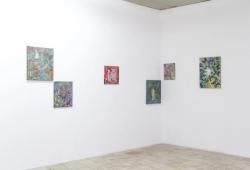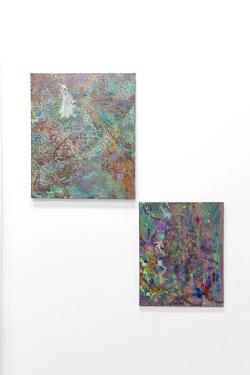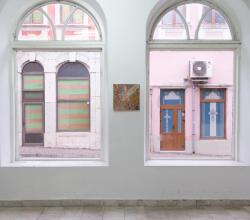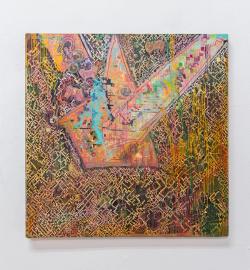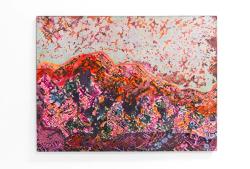Nikola Tsvetanov
Fragments from analog memory.pdf
29.11. – 15.12.2025' /%3E%3C/svg%3E)
Fragments from analog memory.pdf Installation view ' /%3E%3C/svg%3E)
Analog Debris 2025 Oil on canvas ' /%3E%3C/svg%3E)
Pixel Sediments 2025 Oil on canvas ' /%3E%3C/svg%3E)
Glitch Fossils 2025 Oil on canvas (detail) ' /%3E%3C/svg%3E)
Glitch Fossils 2025 Oil on canvas ' /%3E%3C/svg%3E)
Fragments from analog memory.pdf Installation view ' /%3E%3C/svg%3E)
70% Magenta Game 2025 Oil on canvas ' /%3E%3C/svg%3E)
Corrupted Matters 2025 Oil on canvas ' /%3E%3C/svg%3E)
Spirulina Glitch 2025 Oil on canvas ' /%3E%3C/svg%3E)
Light 10% Game 2025 Oil on canvas ' /%3E%3C/svg%3E)
Fragments from analog memory.pdf Installation view ' /%3E%3C/svg%3E)
Pixel Analog 2025 Oil on canvas Fragmented Echoes 2025 Oil on canvas ' /%3E%3C/svg%3E)
Fragments from analog memory.pdf Installation view ' /%3E%3C/svg%3E)
' /%3E%3C/svg%3E)
Noise Relics 2025 Oil on canvas ' /%3E%3C/svg%3E)
Noise Relics 2025 Oil on canvas
In his latest series of paintings, Nikola Tsvetanov returns to the raw materiality of paint as a refuge and an arena — a place where matter resists the digital smoothing of the world. His canvases do not simply bear traces; they accumulate them like geological layers: gestures, erasures, scratches, punctures, traces of physical time that shape their own analog topography. These traces refuse to be translated into the language of the pixel — an analog memory that resists digital transparency.
This insistence of matter resonates with what Lev Manovich defines as post-media sensibility — the state in which analog and digital exist not as opposites, but as mutually penetrating structures. In Tsvetanov, the canvas is at once a damaged screen and a hand-touched surface, an interface and a skin — a boundary through which the viewer sees not just an image, but the tension between two worlds.
His paintings often look like glitch fragments, like damaged monitors in which the “error” becomes a meaning-making element. Here, too, the connection with Kim Cascone’s ideas about post-digital aesthetics emerges—a world in which defect is not a failure, but a place of insight. For Tsvetanov, these defects are not effects; they are wounds. What shines through them is not so much the image as the desire for an image—that primal, sparkling energy through which the world tries to take shape.
The colour clashes, the flickering rhythms between brushstroke and stain, between sign, noise, and erasure, evoke parallels with Wade Guyton, who turns printer’s errors into a primary visual language. But while Guyton translates digital damage onto canvas, Tsvetanov makes the opposite move: his canvas responds to digital culture as a bygone era—as a remnant, as erosion, as a mineral trace.
In the same vein, Hito Steyerl speaks of the poor image — the compressed, worn, overloaded image that bears the marks of its movement. In Tsvetanov, this principle manifests itself as the poor gesture — a gesture that refuses to be smoothed out, refuses to become a pure pixel. It oscillates between visible and disappearing, as if analog flesh struggles not to be dissolved by digital logic.
Boris Groys notes that the materiality of the medium in the age of reproduction becomes a political gesture. In Tsvetanov, materiality is such a statement: the brushstroke as an act of resistance, the paint as a zone of disagreement, the surface as a place that does not allow itself to be reduced to an interface. The painting here is not a picture; it is a territory, a geography, a relief.
Sometimes, a distant resonance with Laura Owens flashes through his work, whose hybrid canvases combine digital layers and manual rhythm. But if Owens expands painting to the space of the screen, Tsvetanov returns it to its primary body — to gesture, to friction, to imperfection as truth. He does not simulate the digital, but translates it back through matter, as if freeing it from its own illusion. This can be both a slow, drawn-out, sometimes painful process, and a meditative and healing creation and contemplation of mutually attracting opposites.
Thus, a sense of post-digital archaeology takes shape in his canvases: painting breaks down the layers of the digital age and unearths its forgotten corporeality beneath them — paint as flesh, surface as skin, gesture as testimony. Each fragment vibrates between hand and pixel, between analog weight and digital weightlessness.
The image here does not tell a story — it self-decomposes, reveals the mechanics of its own emergence, migrates between matter and light, between gesture and defect. What remains is a living organism: a painting that is simultaneously created and destroyed, leaving traces of its own becoming in the field of view.
In this post-digital landscape, Nikola Tsvetanov does not work against the digital. He works on its ruins, on its debris and reflections, on the instability that reveals what remains human after the age of the screen. It is there, in this zone of resistance and transformation, that painting begins to breathe again. - Ivo Ivanov (Studio DauHaus)
Nikola Tsvetanov was born in 1998 in Sofia. In 2017, he graduated from the National Secondary School of Fine Arts "Iliya Petrov", majoring in "Book Illustration and Design". He studied for one year in the "Visual Arts" program at New Bulgarian University (2017 - 2018). In 2018, he was accepted as a student at the National Academy of Arts in Sofia where he received a master's degree in the "Graphic Arts" major in 2024. The same year he specialized at the Arte Ederren Fakultatea UPV/EHU (Bilbao, Spain) and worked as a trainee assistant to Professor David Arteagoitia in the field of contemporary graphic arts. He has participated in numerous local and international exhibitions: Incognito Games, Atelie 28 Gallery, Sofia (2025); Drawing as a Way of Thinking, Atelie 28 Gallery, Sofia (2025); Sofia Underground - International Performance Art Festival (2023); Residency for Contemporary Graphic Print in North Macedonia, exhibition in Bogdanci and Skopje (2023); Daring to Defy the Status Quo - double fold exhibition in Doza Gallery, Sofia and Aether Haga, Netherlands (2023); 9 Park Camp, Trebisov, Slovakia; Cold. Warm. Warmer. Hot., Academy of Arts Gallery in Banská Bystrica, Slovakia (2022-2023); Game Lover, Arosita Gallery, Sofia (2022); System Change, Anyway or a Sense of Painting, Art Center Bankya, Sofia (2022); Rearrangement of Layers, 32nd Festival "Process - Space", Balchik (2021); Third National Graphic Arts Competition - Classical Techniques, Sredets Gallery, Sofia (2021) and more
@StudioNikiCvetanov
Фрагменти от аналогова памет.pdf
Изложба на Никола Цветанов
В най-новата си серия живописни работи Никола Цветанов (@StudioNikiCvetanov) се завръща към суровата материалност на боята като към убежище и арена — място, където материята упорства срещу дигиталното изглаждане на света. Платната му не просто носят следи; те ги натрупват като геоложки пластове: жестове, изтривки, надрасквания, пробиви, следи от физическо време, които оформят собствена аналогова топография. Тези следи отказват да бъдат преведени на езика на пиксела — аналогова памет, която се съпротивлява на дигиталната прозрачност.
Това настояване на материята резонира с онова, което Лев Манович определя като постмедийна чувствителност — състоянието, в което аналоговото и дигиталното съществуват не като противоположности, а като взаимно проникващи се структури. При Цветанов платното е едновременно повреден екран и ръчно докосната повърхност, интерфейс и кожа — граница, през която зрителят вижда не само образ, а напрежението между два свята.
Неговите картини често изглеждат като glitch-фрагменти, като повредени монитори, в които „грешката“ се превръща в смислообразуващ елемент. Тук се появява и връзката с идеите на Ким Каскон за post-digital естетика — свят, в който дефектът е не провал, а място на прозрение. При Цветанов тези дефекти не са ефекти; те са рани. През тях проблясва не толкова изображението, колкото желанието за образ — онази първична, искряща енергия, чрез която светът се опитва да вземе форма.
Цветовите сблъсъци, трептящите ритми между мазка и петно, между знак, шум и заличаване, извикват паралели с Уейд Гайтън, който превръща принтерните грешки в основен визуален език. Но докато Гайтън превежда дигиталната повреда върху платното, Цветанов прави обратното движение: неговото платно реагира на дигиталната култура като на отминала епоха — като на остатък, като на ерозия, като на минерална следа.
В същия дух Хито Стейерл говори за poor image — компресираното, износено, пренатоварено изображение, което носи белезите на своето движение. При Цветанов този принцип се проявява като poor gesture — жест, който отказва да бъде изгладен, отказва да стане чист пиксел. Той трепти между видимо и изчезващо, като че ли аналоговата плът се бори да не бъде разтворена от дигиталната логика.
Борис Гройс отбелязва, че материалността на медиума в епохата на репродукцията се превръща в политически жест. При Цветанов материалността е такова твърдение: мазката като акт на съпротива, боята като зона на несъгласие, повърхността като място, което не позволява да бъде сведено до интерфейс. Живописта тук не е картина; тя е територия, география, релеф.
Понякога в работите му проблясва и далечен резонанс с Лора Оуенс, чиито хибридни платна съчетават дигитални слоеве и ръчен ритъм. Но ако Оуенс разширява живописта към пространството на екрана, Цветанов я връща към нейното първично тяло — към жеста, към триенето, към несъвършенството като истина. Той не симулира дигиталното, а го превежда обратно през материята, сякаш го освобождава от собствената му илюзия. Това може да бъде както бавен, протяжен, понякога и болезнен процес, така и медитативно и лекуващо създаване и съзерцание на взаимно привличащи се противоположности.
Така в неговите платна се оформя усещане за постдигитална археология: живописта разравя пластовете на дигиталната епоха и откопава под тях забравената си телесност — боята като плът, повърхността като кожа, жестът като свидетелство. Всеки фрагмент вибрира между ръка и пиксел, между аналогова тежест и дигитална безтегловност.
Изображението тук не разказва история — то се саморазгражда, разкрива механиката на собственото си възникване, мигрира между материя и светлина, между жест и дефект. Това, което остава, е жив организъм: картина, която се създава и разрушава едновременно, оставяйки в полето на погледа следите от собственото си ставане.
В този постдигитален пейзаж Никола Цветанов не работи против дигиталното. Той работи върху неговите руини, върху неговите отломки и отблясъци, върху нестабилността, която разкрива какво остава човешко след епохата на екрана. Точно там, в тази зона на съпротива и трансформация, живописта започва отново да диша. - Иво Иванов (Студио Даухаус)
